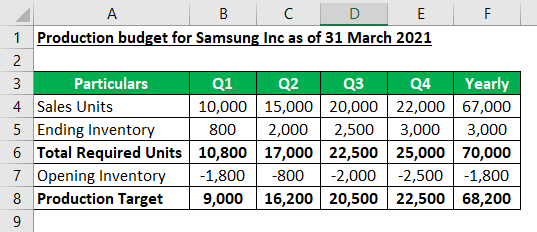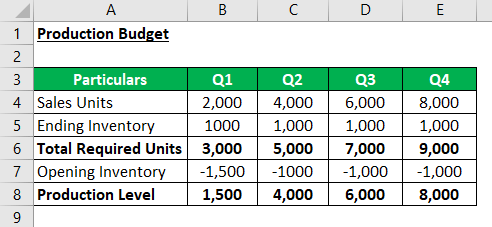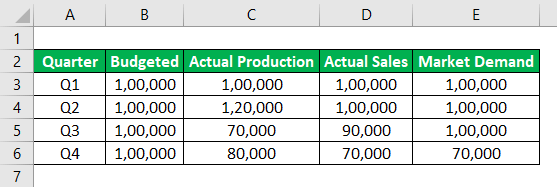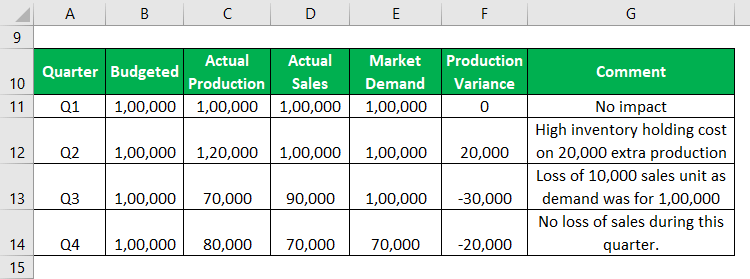Updated July 13, 2023
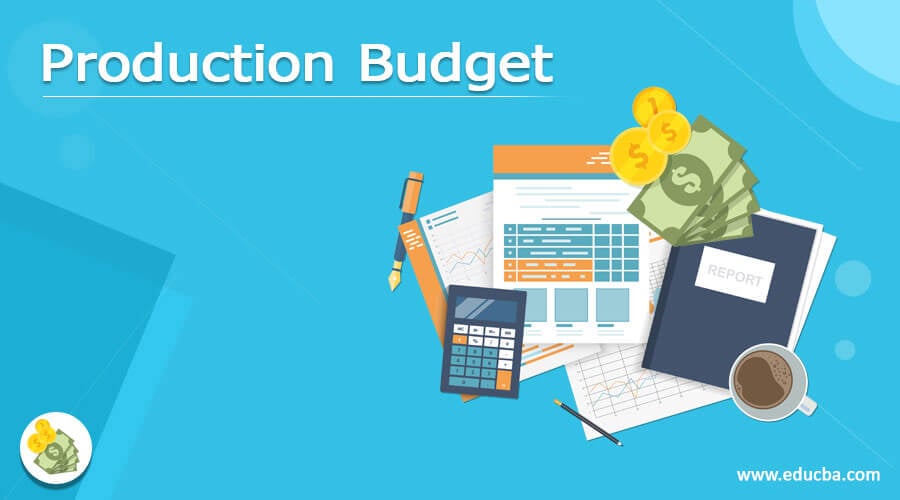
What is the Production Budget?
Production budget can be defined as a financial estimate that calculates and connects the total number of units to be manufactured/ processed by the organisation as desired by management for the budgeted period in order to fulfil the desired sales quantity and is prepared based on the organisation’s perception pertaining to economic situations, market competitors, organization production capacity, market demands etc.
Explanation
The production budget is one of the components of an annual business plan which calculates and presents the number of units to be produced by a company in a given period of time and is derived based on a mixture of future sales prediction, customer demand prediction, finished product inventory management and various other such factors. It is mainly created for setting up weekly/ monthly/ quarterly production targets for employees/ workers. It is mostly prepared on a monthly, quarterly/ annual basis. It is quite tough to make a detailed production budget that includes a projection of every product the organisation sells. Therefore, the products of similar qualities are grouped together, and a wide prediction is made for all.
Proper inventory estimates of finished goods is a matter of concern as having a huge amount of stock may lead to an increase in inventory holding cost, wastage of inventory being getting obsolete and may even be required to be sold off at a loss while on the other hand, a low level of inventory may hamper sales due to unavailability of adequate inventory levels. It is dependent on three factors-
- Sales Forecast: An entity needs to determine its sales forecast. The number of units to be sold in the desired period is always the starting point for the production budget.
- Opening Inventory in hand: Quantity of finished goods the company already has at the beginning of the period.
- Closing Inventory in hand: Quantity of closing stock that the company desires to maintain at the end of the budgeted period.
Examples of Production Budget
Let us look at the below examples of the Production Budget with calculations:
Example #1
Samsung Inc., a manufacturer of mobile phones, has forecasted the sales figures for the next year ending on 31 March 2021. The sales quantity in the next year is 10000 units in quarter 1, 15000 units in quarter 2, 20000 units in quarter 3, 22000 units in quarter 4. The management also estimates the ending inventory of quarter 1 as 800 units, quarter 2 as 2000 units, quarter 3 as 2500 units and quarter 4 as 3000 units. On looking into the companies data, it was found that the opening inventory of quarter 1 was 1800 units. Therefore, prepare a production budget for Samsung Inc.
Solution:
Therefore, production levels for units to be produced by Samsung Inc. is 9000 units in quarter1, 16200 units in quarter 2, 20500 units in quarter 3 and 22500 units in quarter 4.
Example #2
The company’s sales budget shows the sales figure for the year as 1000, 2000, 3000, and 4000 units of each quarter respectively. The estimated ending stock is 1000 units of each quarter. The opening inventory of quarter 1 was 1500 units. The company is in need of its production budget.
Solution:
Therefore, the company needs to produce 1500, 4000, 6000 and 8000 units respectively in each quarter to meet the needs of the customers.
Example #3
Mentioned below are the production budget and its relevant period actual sales. Determine variance and comment whether the company incurred higher inventory holding costs or failed to meet customer requirements for each quarter:
Solution:
What is Included in the Production Budget?
A production budget simply reflects finished goods quantity that needs to be produced and maintained by an organization. A typical production budget template is presented below for a better understanding of the concept: –
| AMC Inc. | |||||
| Production Budget | |||||
| For the FY 2020 | |||||
| Particulars | Q1 | Q2 | Q3 | Q4 | Yearly/ Year-End |
| Sales/ Stock Transfer | 1,10,000 | 1,20,000 | 1,30,000 | 1,40,000 | 5,00,000 |
| ADD: Closing Stock (To be maintained at period end) | 30,000 | 20,000 | 10,000 | 10,000 | 10,000 |
| LESS: Opening Stock (To be maintained at beginning of period) | (10,000) | (30,000) | (20,000) | (10,000) | (10,000) |
| Production | 1,30,000 | 1,10,000 | 1,20,000 | 1,40,000 | 5,00,000 |
A production budget is divided into various costs incurred, such as direct material, direct labour and overheads. Further, all these components will have their separate cost budget.
Lets, briefly discuss these components: –
Material budget is the estimated quantity of raw materials that are required to meet the budgeted production quantities. A material budget contains details of all the material costs that the organisation incurs. Material budget shares similarities with the production budget as here also, management must decide the number of raw materials to be available at the end of the quarters.
A direct labour budget is a financial tool that calculates and presents estimated labour hours required to produce the item mentioned in a production budget. With the help of a typical direct labour budget, category wise labour hours can be calculated to produce an item. Thus, it is used in forecasting the employees that are required in the manufacturing process. In addition, it helps the management to determine its hiring needs. Some examples of costs included in the direct labour budget are commission, wages, bonus, overtime payments, etc.
Production budgets are set based on this material budget, labour budget, and overhead cost budget in the same way sales budget sets for the production budget.
Advantages
- The production budget sets the targets for the company that need to be achieved during the budgeted period and hence provides the guidelines and strategy for operations.
- It aids in sustaining an equilibrium between stock position, sales and level of production of the organisation and helps in implementing plans and policies concerning them.
- It helps in maximum utilization of labour, plant and machinery of the organisation.
- Setting targets motivates the management and employees to work more rigorously to accomplish the goals in time and with more efficiency.
Disadvantages
- Production budget works on analysis and estimates of the organisation’s management. The actual situation may be different, and it may not be possible to attain the expected production level in a real-world competitive market.
- Preparation of production budget is quite a time consuming and involves much effort for the organisation management.
- It is not possible for the newly established business as there is no experience and historical data.
Conclusion
It determines and sets the production level of an organisation and sets targets for its employees to be achieved with more efficiency during the budgeted period. Each organisation has its own policies and plans. Organizations can compare and analyse their original production so as to understand variances and take corrective action. However, it requires more time in their preparation and is more complex for small businesses due to a lack of required data and resources.
Recommended Articles
This is a guide to the Production Budget. Here we discuss the definition and example along with the advantages and disadvantages of the Production Budget. You may also look at the following articles to learn more –
